Sections
Key message

What, why and where?
Atlantic salmon are one of Scotland’s most iconic species, forming an important part of river ecosystems and, through salmon fisheries, contributing to the rural economy. They live in fresh water as juveniles before migrating to sea to undertake migrations to their oceanic feeding grounds in the North Atlantic. As adults they return to the rivers in which they grew up where they then spawn and begin the next generation.
Scottish Government has collected, and published, the catches of salmon and sea trout reported by fisheries each year since 1952 (Figure 1). Fisheries fall into one of three broad categories: fixed engine (passive nets which the fish must actively swim into), net and coble (the use of a sweep net to surround the fish and draw them to the bank or shore) and rod fisheries. Catch statistics (Figures 2 to 5) are published as doi datasets (Scottish Government, 2019a).
Salmon and sea trout catches by all methods have declined between 2014 and 2018. This is the result of reductions in stocks and restrictions/prohibitions on salmon fishing activities to aid stock recovery. In particular, coastal salmon netting has been prohibited since 2016 and the netted catch of salmon from the sea is zero. Additionally, other fisheries may only take salmon where river stocks have been shown to be in good conservation status.
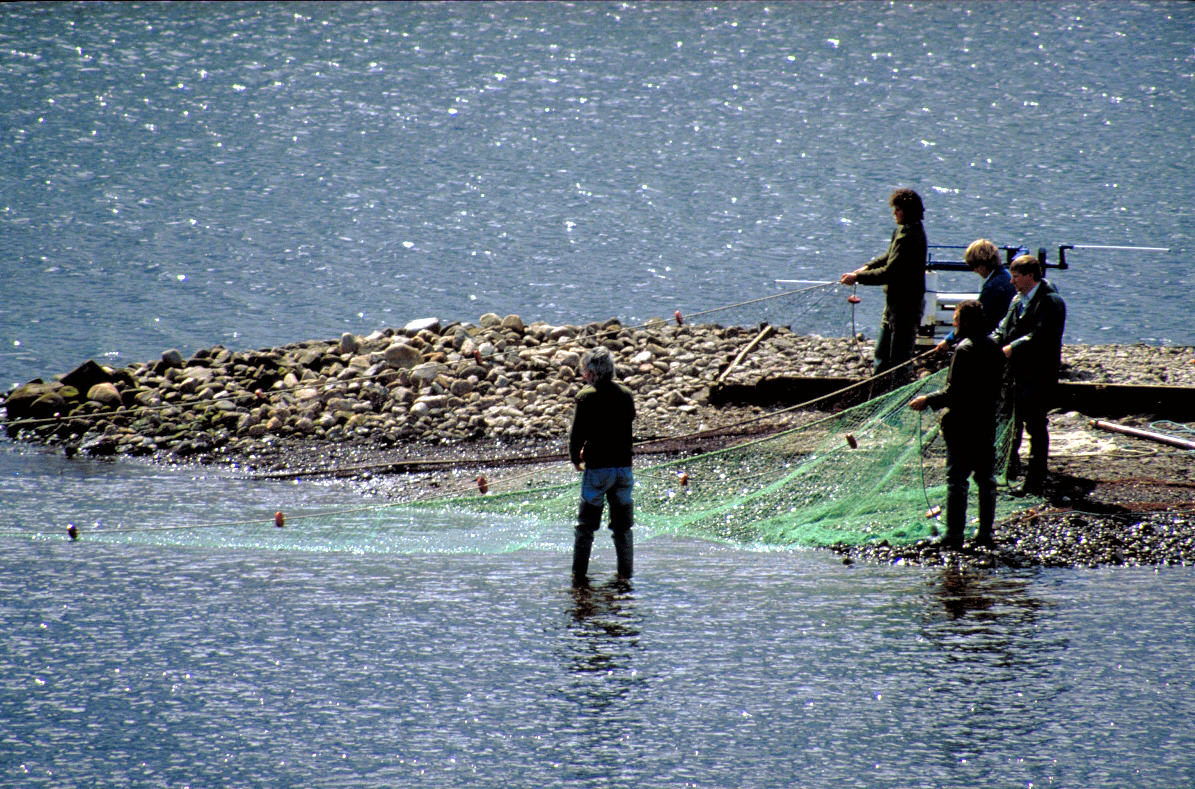

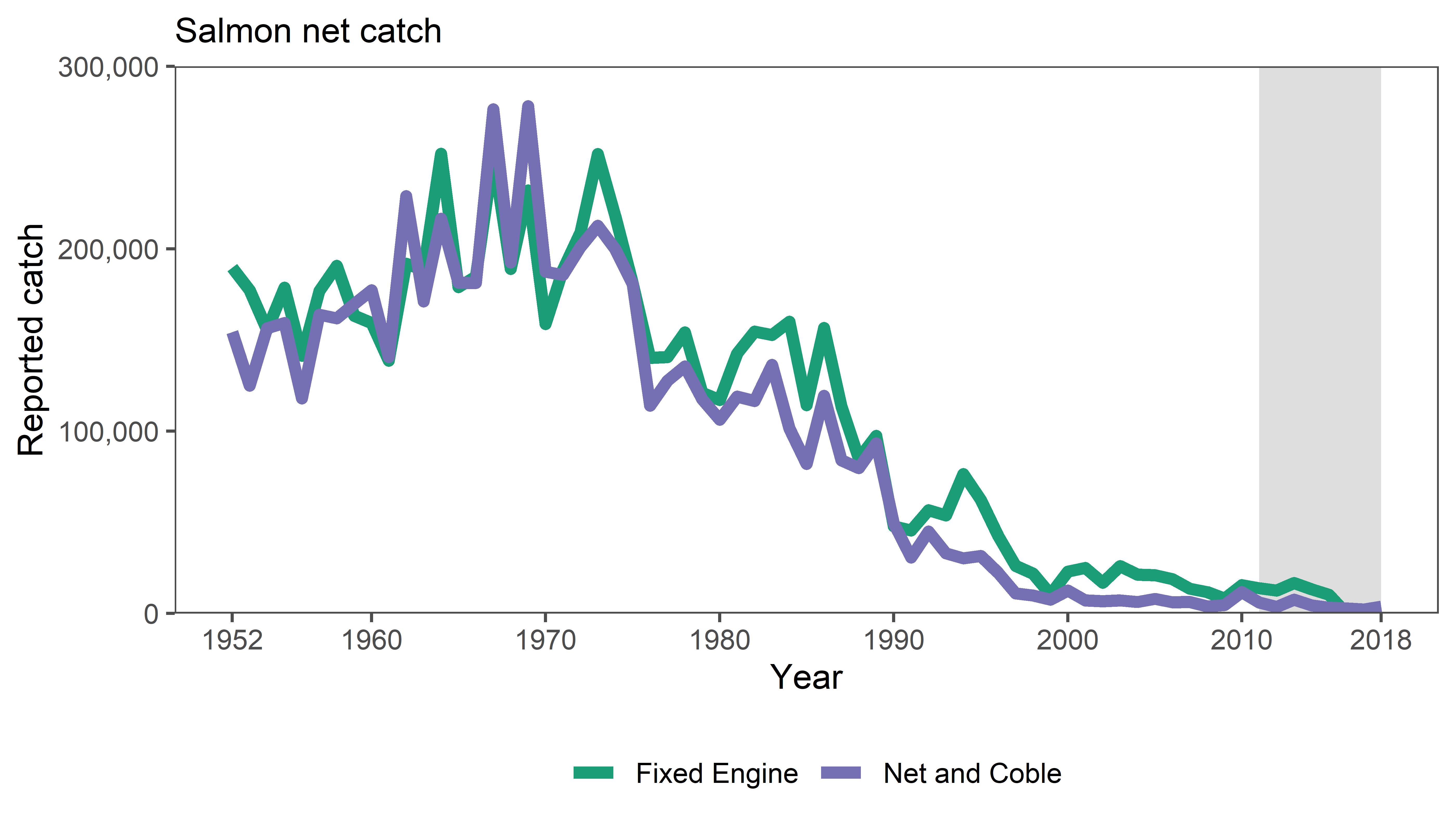
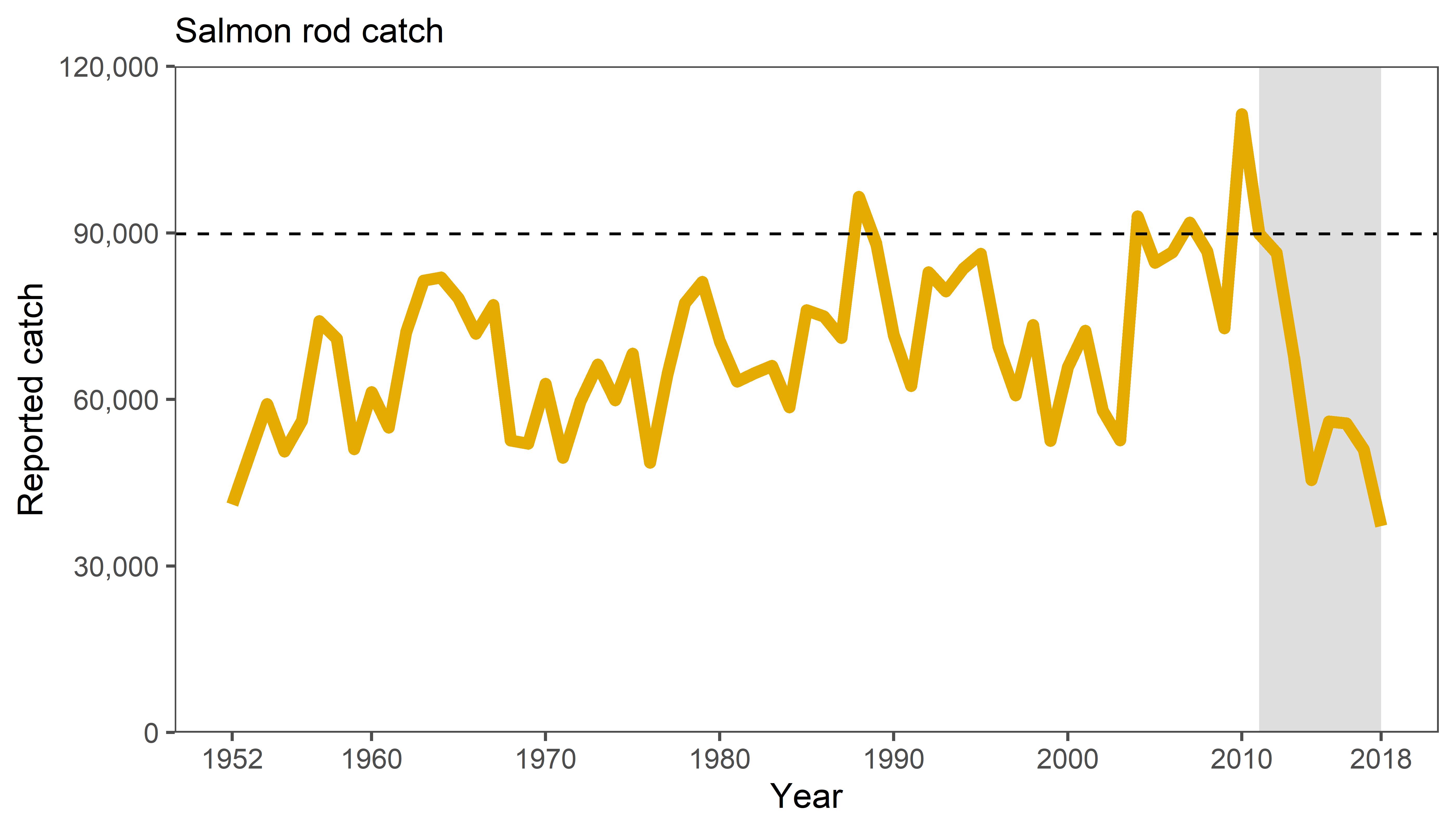
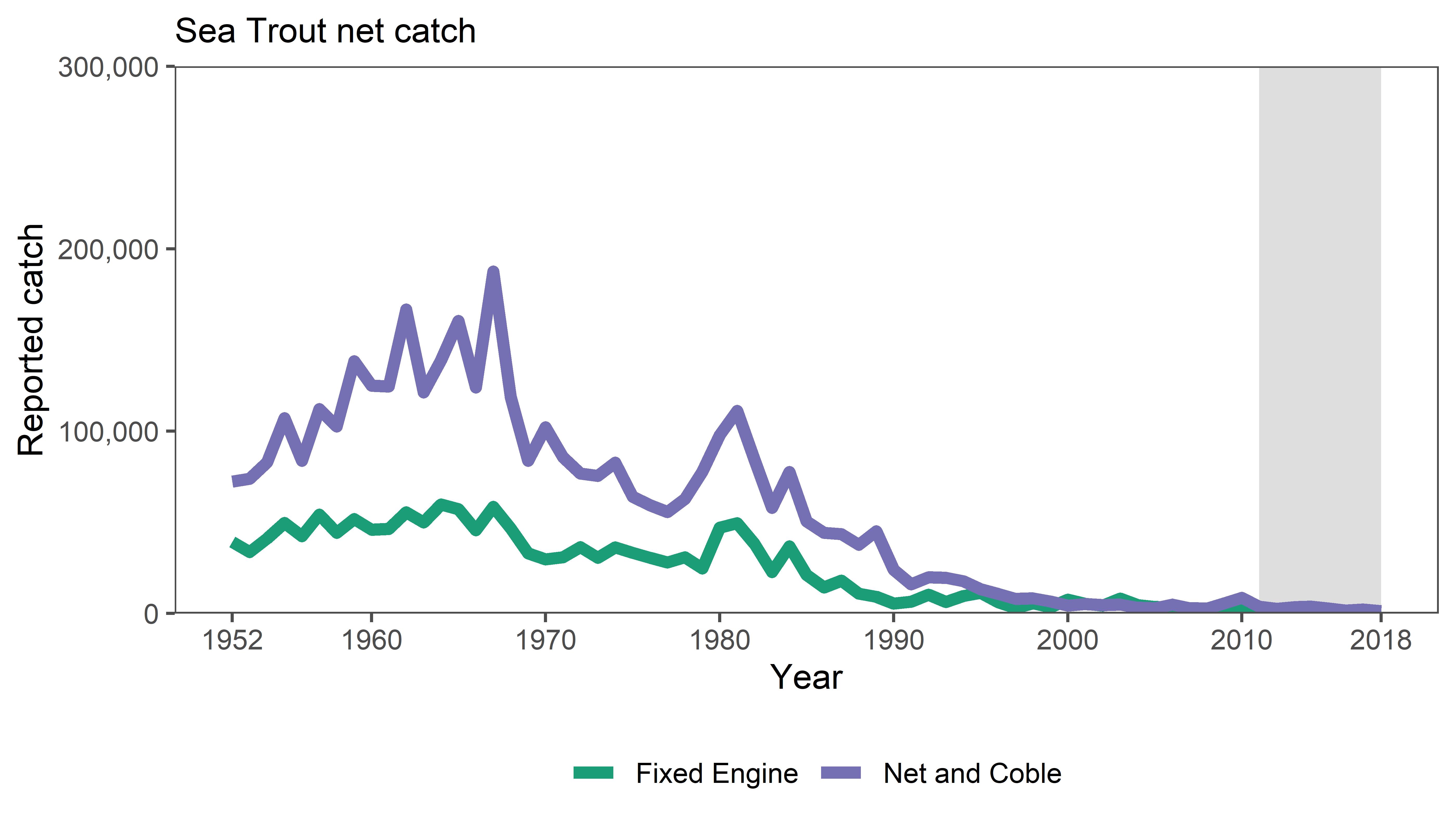
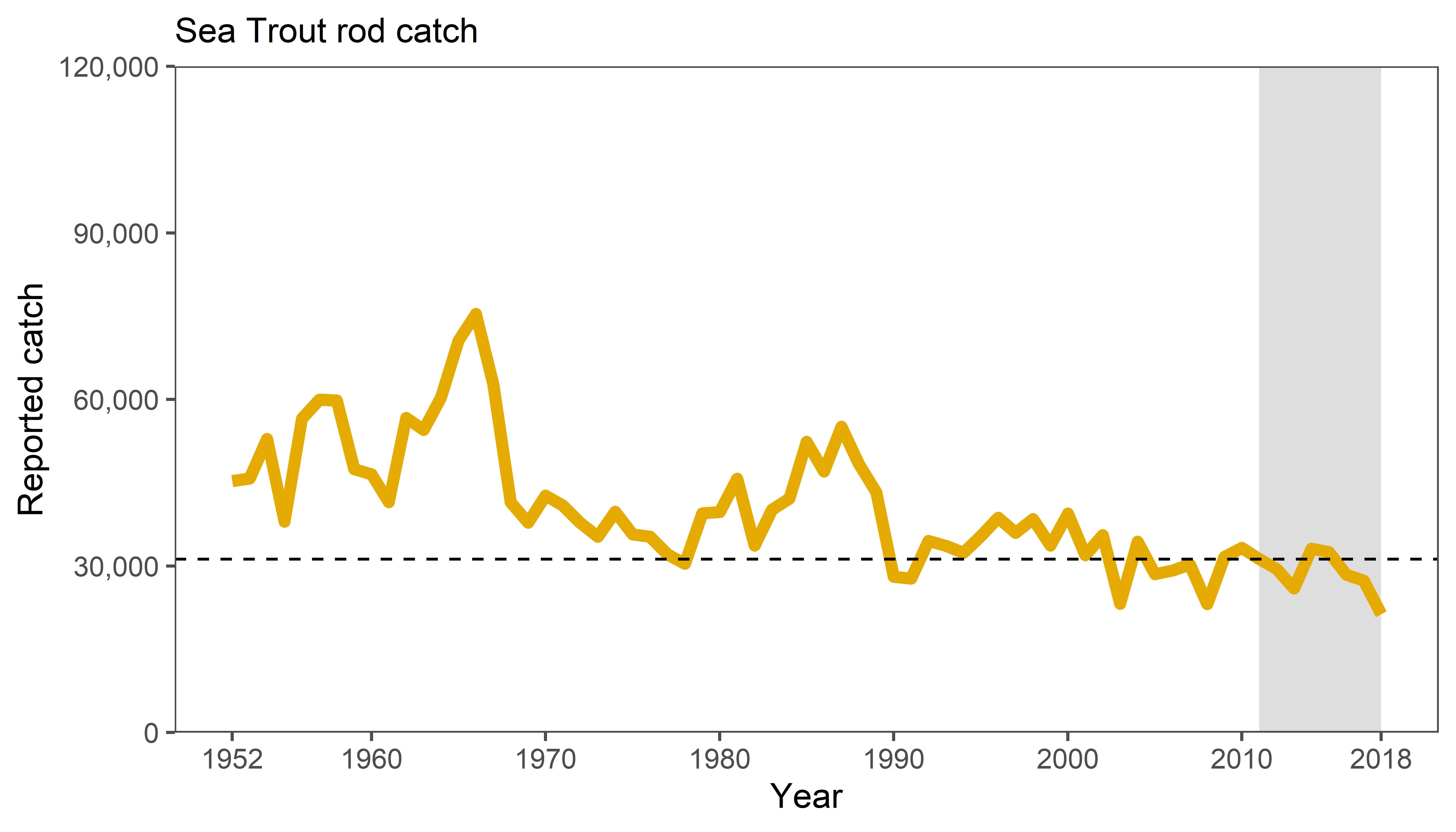
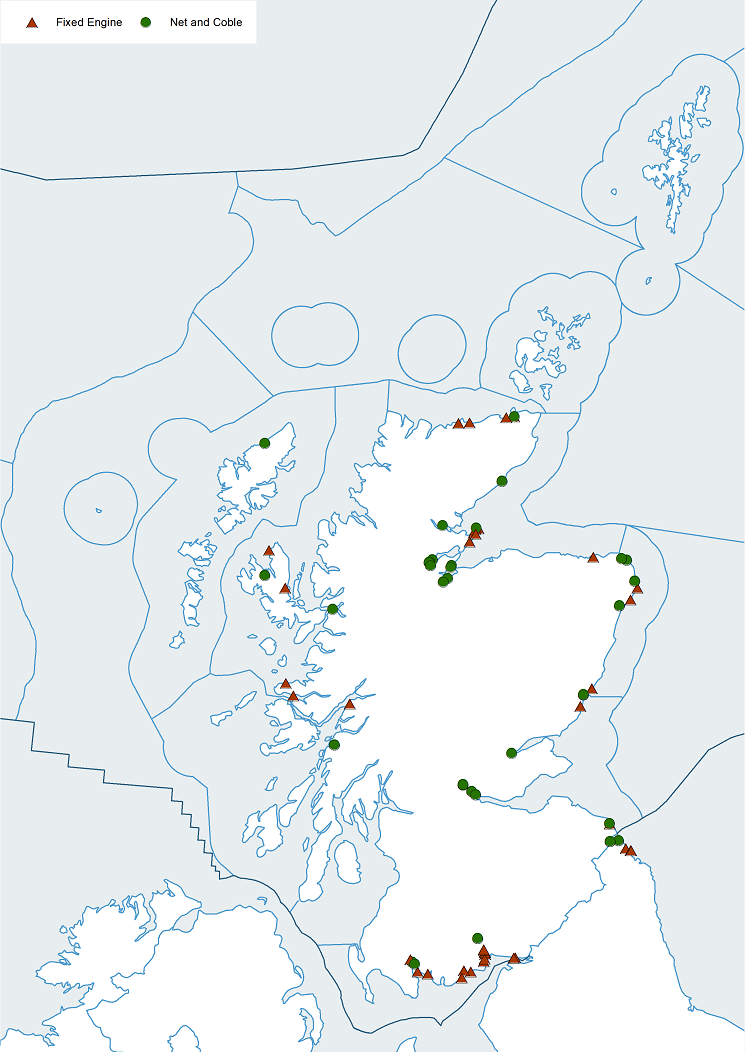
Salmon and sea trout fishery statistics are based on annual returns from proprietors, occupiers or agents of fisheries throughout Scotland and have been collected annually since 1952. These data are derived from approximately 2,000 forms issued each year. Catch data are collected from 109 Districts. Districts correspond either to a single river catchment together with the adjacent coast or to groups of neighbouring river catchments and their associated coastline.
Over the past 10 years return rates of forms have been around 93%. These statistics are part of a time series which began in 1952 and are collected and collated by Marine Scotland as Official Government Statistics, subject to a quality assurance process before being published (Scottish Government, 2019b). Districts can also be combined into Scottish Marine Regions (SMRs).
Salmon and sea trout fisheries fall into one of three broad categories:
- Fixed engine fisheries are restricted to the coast and must be set outside estuary limits. Bag-nets, stake nets and jumper nets are different forms of fishing gear used across Scottish fisheries, with poke nets and haaf nets restricted to the Solway Firth area. Since 2016 removal of salmon from coastal nets has been prohibited, covering all fixed engines except the Solway haaf nets.
- Net and coble fisheries generally operate in estuaries and the lower reaches of rivers. Since 2016 these fisheries may only take salmon where river stocks have been shown to be in good conservation status.
- Rod and line fisheries comprise angling activities which generally take place within rivers and above tidal limits. This method currently accounts for the majority of salmon and sea trout catches. Since 2016 rod fisheries have only been allowed to retain salmon on rivers that have shown to be in good conservation status. In all other rivers rod caught salmon must be released.
In response to concerns over stock levels coastal netting is currently prohibited and the netted catch of salmon from the sea is therefore zero. Rod catches, and the remaining net catches, provide information on the economic benefit from rivers flowing into these regions but cannot be used to infer anything about salmon stocks within the sea or Scottish Marine Region (SMR) itself.
Salmon
Since the 2011 Assessment there have been a number of measures which have had an impact on salmon catches. In 2016 statutory conservation measures were introduced to prohibit the removal of salmon from coastal waters and on stocks with poor conservation status (Scottish Government, 2019c). Locations of stocks estimated to be in poor conservation status are spread throughout the country.
Net fisheries
Reported catches from fixed engine and net and coble fisheries have declined over much of the period since records began in 1952 and are at historically low levels (Figure 2). Since 2016 retaining salmon caught in coastal waters has been prohibited. The 2016 regulations also prevented net and coble fisheries operating where salmon stocks were in poor conservation status. The decline in effort (Figure a) is due to a number of factors. These include economic competition due to the availability of farmed salmon; a decline in wild salmon stocks, particularly in the spring months leading to lower catches and therefore profits; the rights to netting stations being bought and not fished by wild fish interests and regulations curtailing the fishing season due to concerns about salmon stocks.
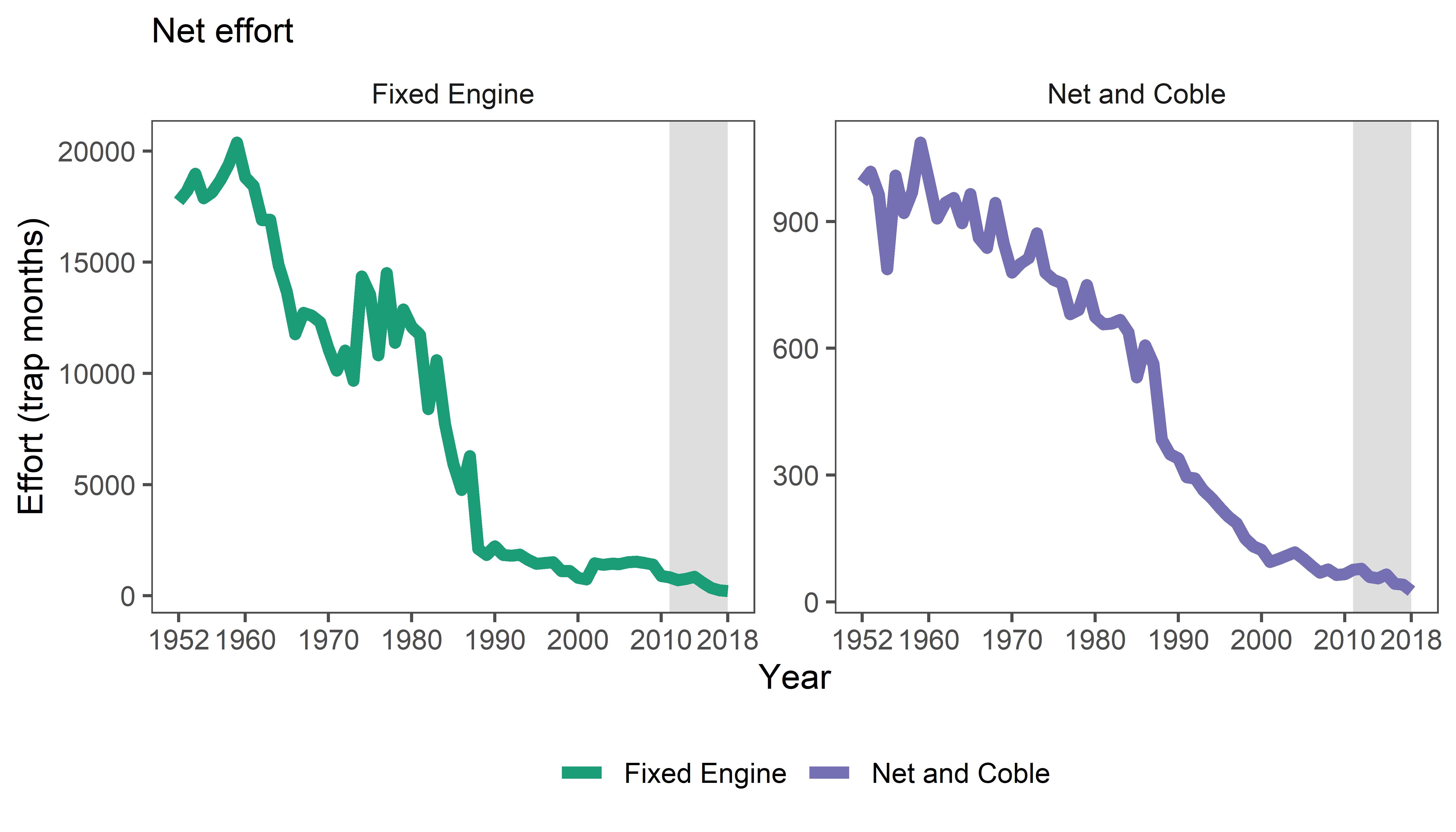
Rod fisheries
Annual catches for the rod fisheries have declined steeply since the highest recorded level in 2010 (Figure 3). The catch in 2018 was the lowest recorded being one third of the 2010 figure, and two thirds of the previous 5-year average. Although the scale of the decline in 2018 was undoubtedly influenced to some extent by drought conditions in many rivers, the pattern was mirrored in other countries (ICES, 2019), highlighting that low catches in 2018 reflect continuation of a real decline in salmon numbers.
Sea Trout
Net fisheries
Reported catch and effort in both fixed engine and net and coble fisheries have declined over much of the period covered by Marine Scotland’s records and remain at low levels (Figures 4 & a). In 2018, reported catch and effort for both the fixed engine and net & coble fisheries were the lowest recorded by either fishery since records began in 1952.
Rod fisheries
Total rod catches of sea trout for Scotland as a whole have declined over much of the period since 1952, when records began. The total reported rod catch of 13,692 in 2018 was the lowest in the time series and 69% of the previous 5-year average (Figure 5).
The recent trends in the number of salmon and sea trout caught by nets in the sea and estuaries show a clear decline with recent catches at their lowest levels since 1952. This decline has been ongoing for a number of years and is the product of a number of factors. Since 2016 these declines have been heavily influenced by the prohibition in removing salmon by offshore nets and by estuarine nets in areas where the status of salmon stocks is poor, for example parts of the Moray Firth SMR.
From an economic point of view the value of salmon and sea trout fishing in the sea has clearly declined in recent years. This is also the case for rod fisheries in the rivers flowing into Scottish coastal waters. The trends seen in rod fisheries are different to those shown by the nets, but for salmon have shown a decline in the years since the last assessment, going from the highest catches since 1952 in 2010 to the lowest in 2018. Catches of sea trout are also at the lowest over the time series.
Catches from the fishery districts can be amalgamated to replicate the SMRs. See figures b to s below. The Shetland and Orkney SMRs do not have associated catches.


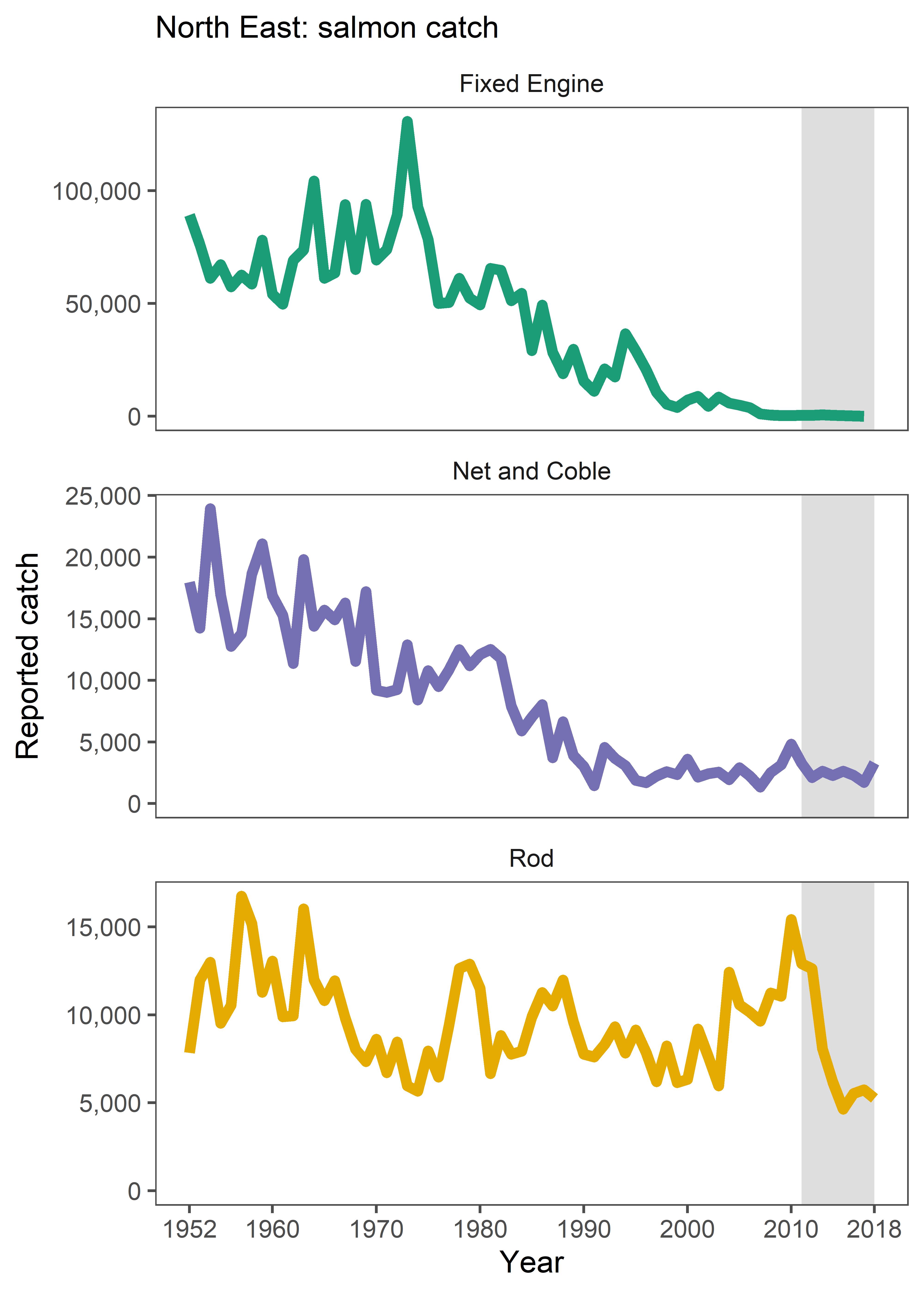
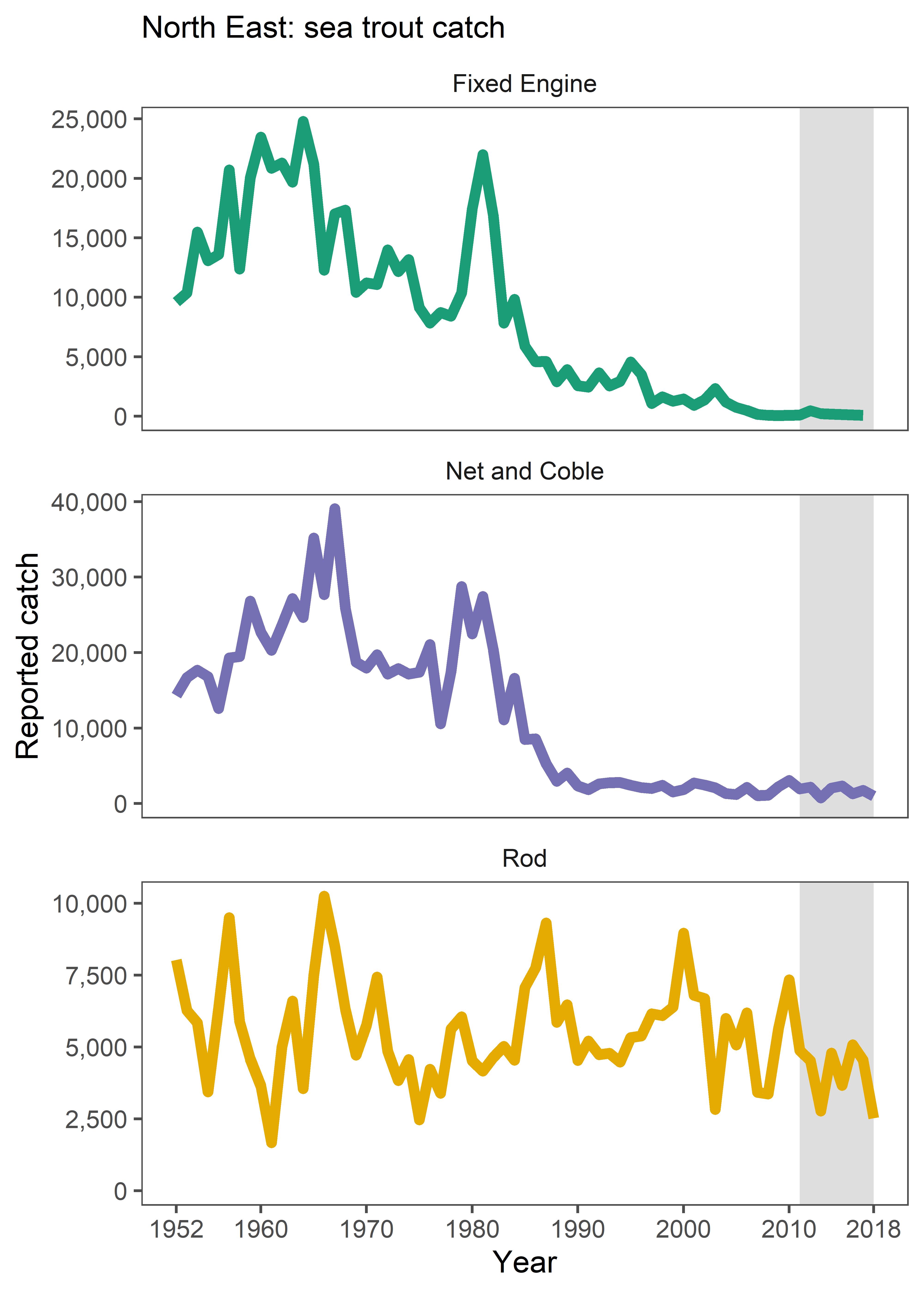
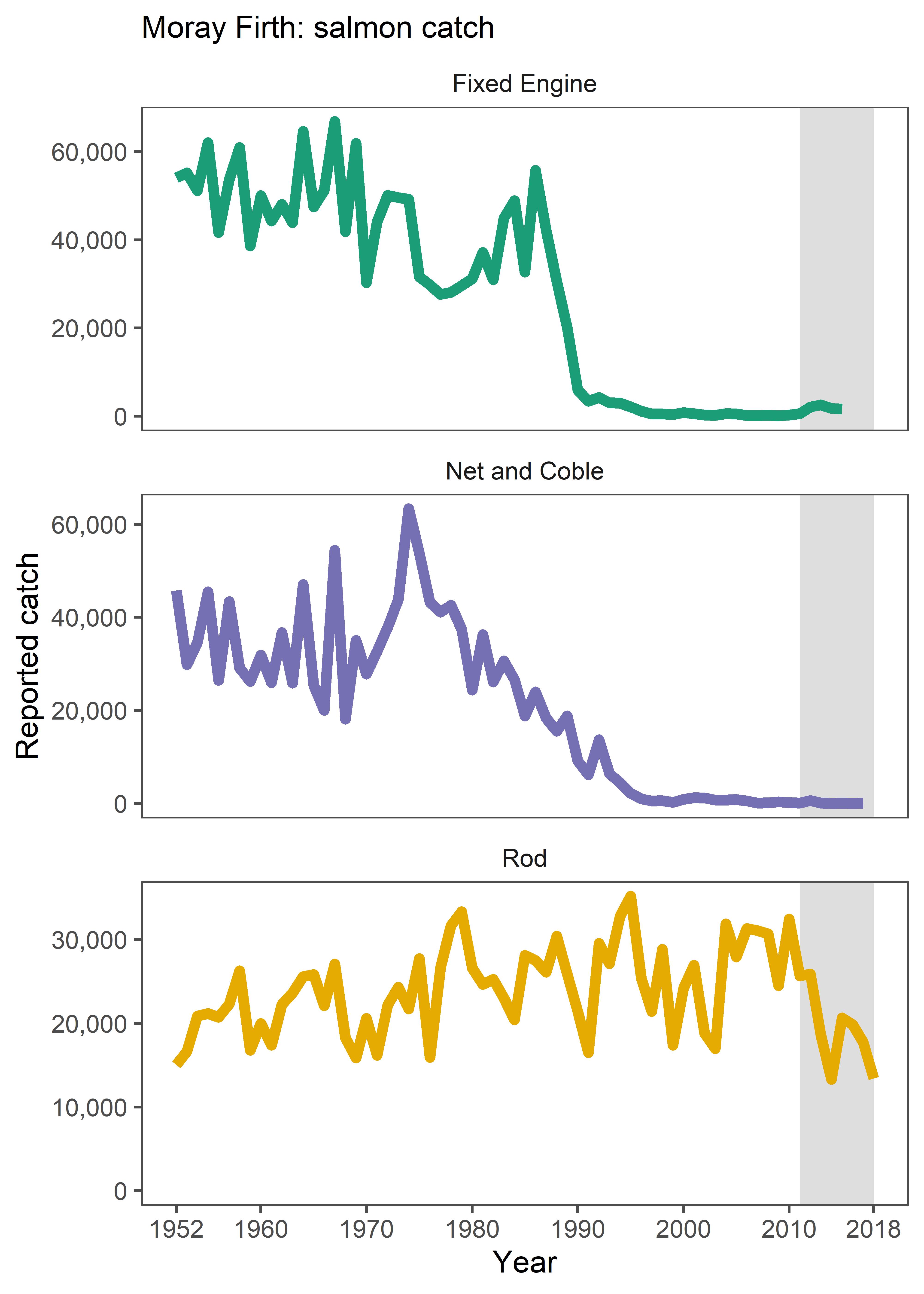
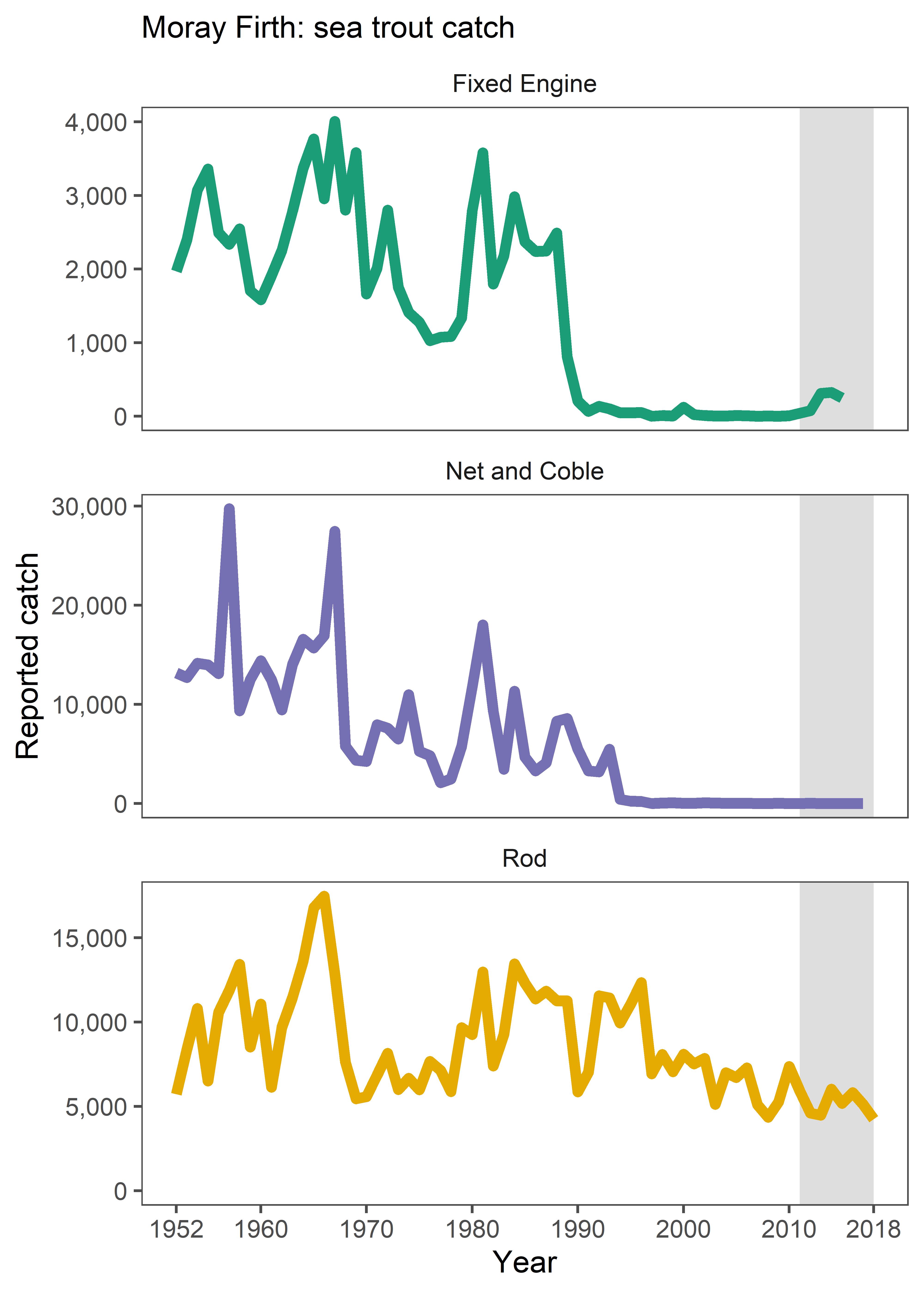
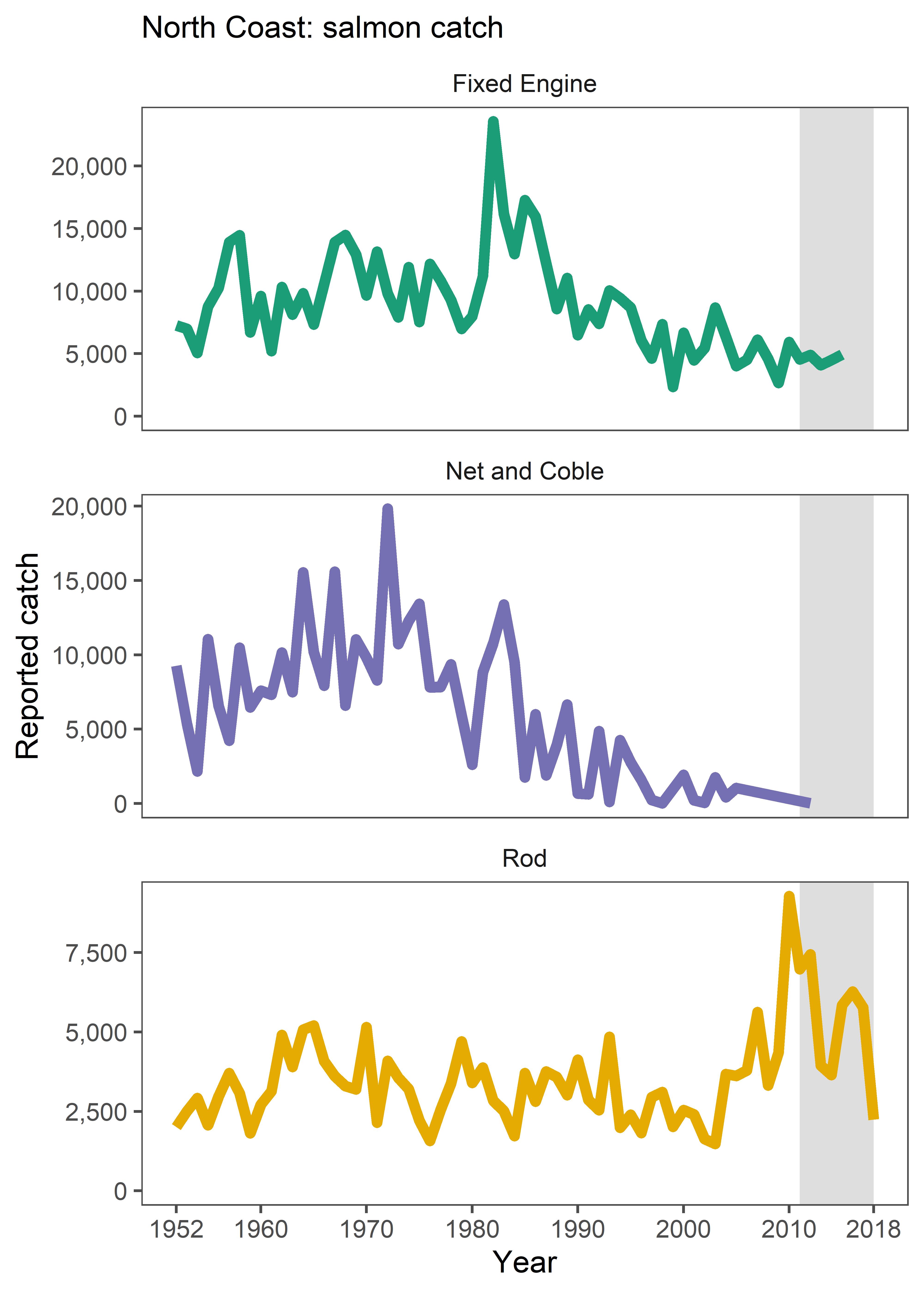

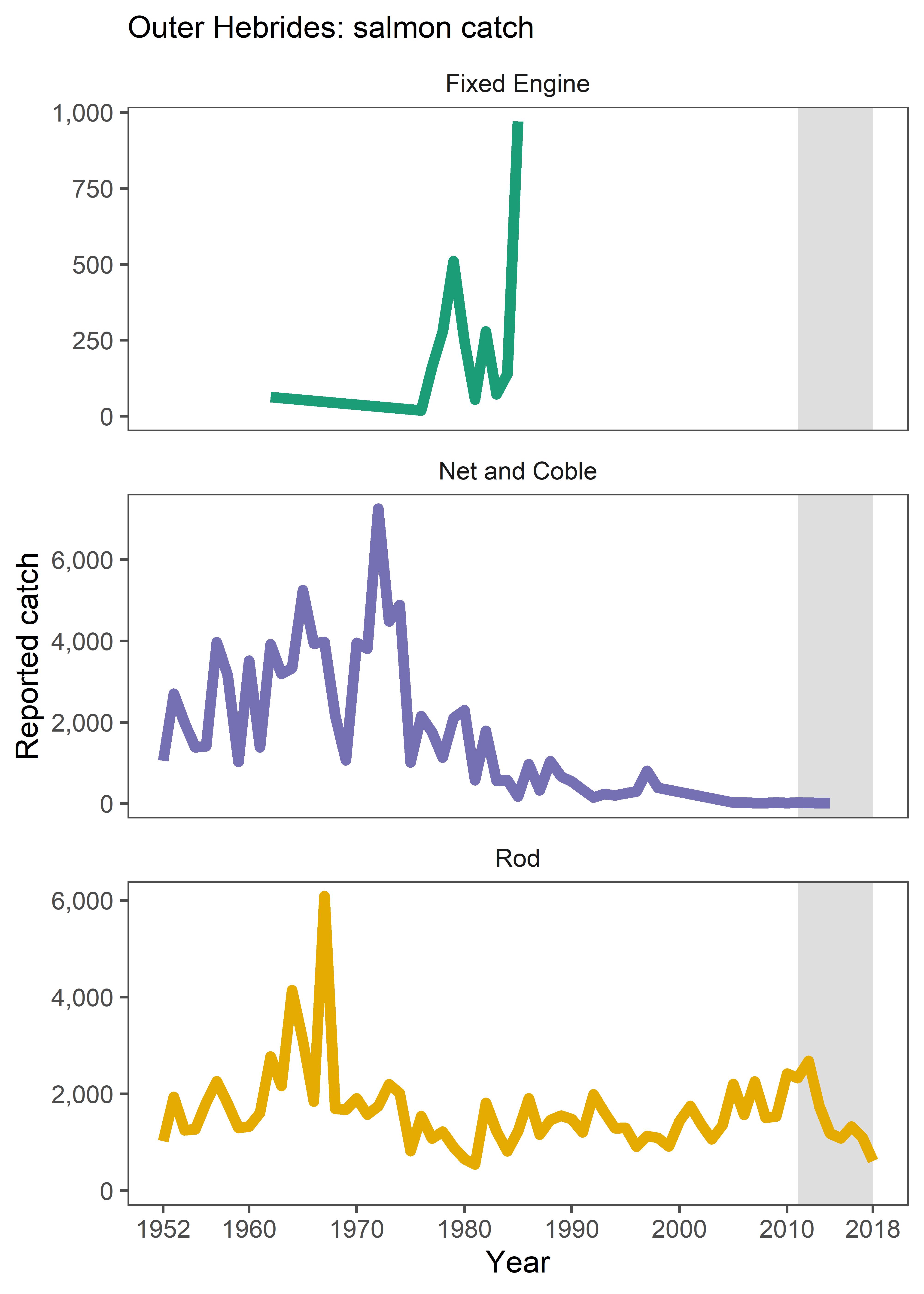
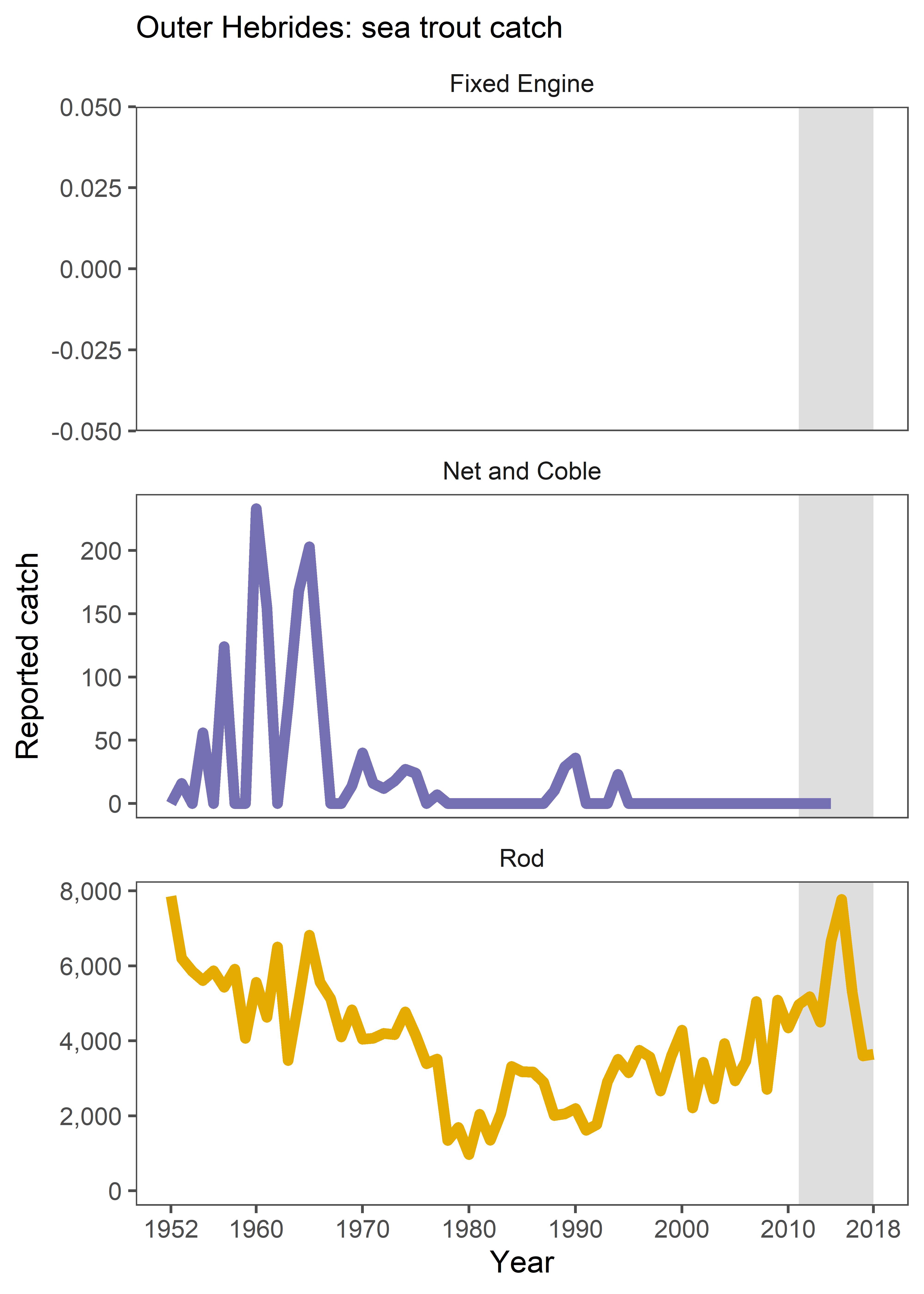
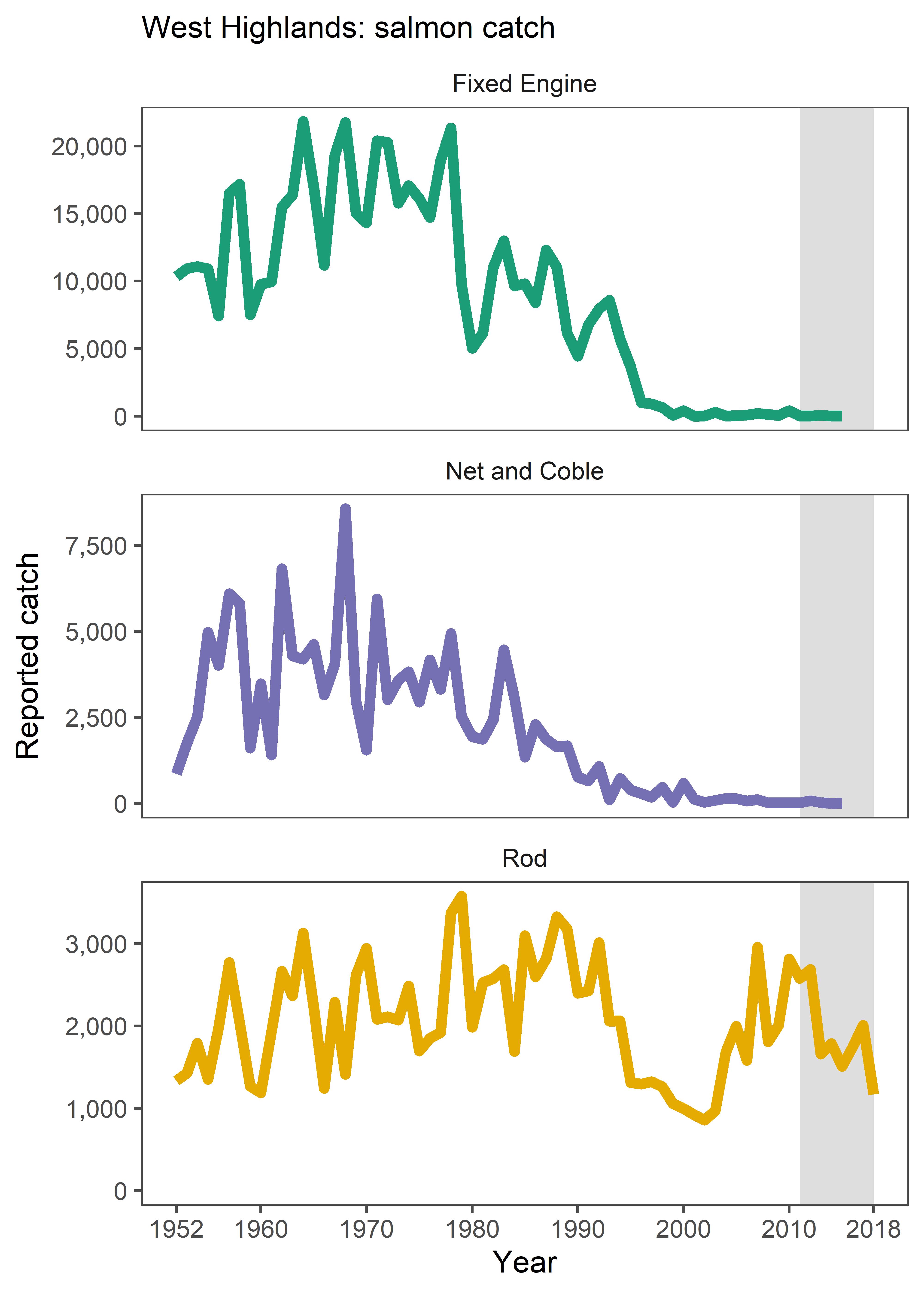
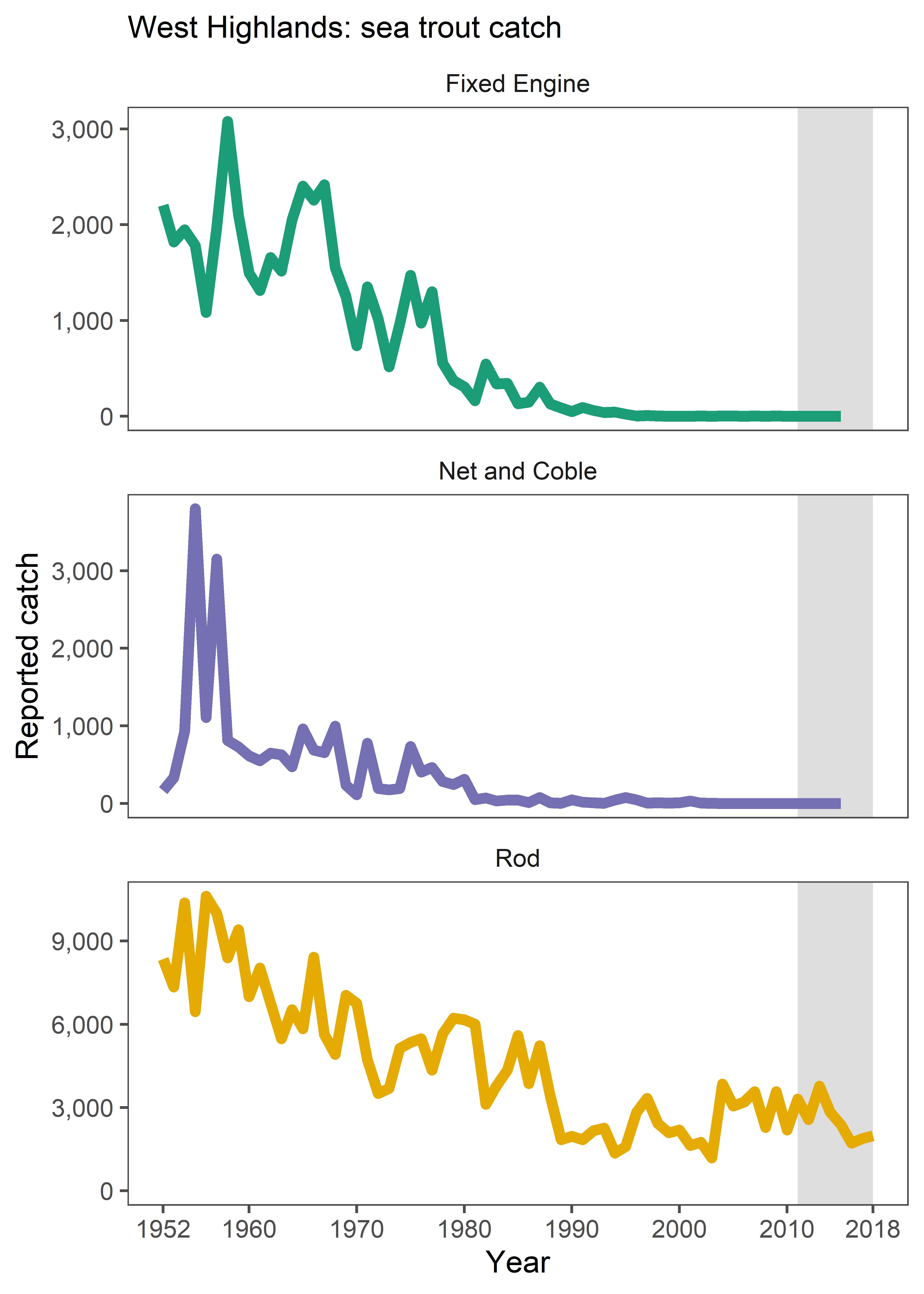
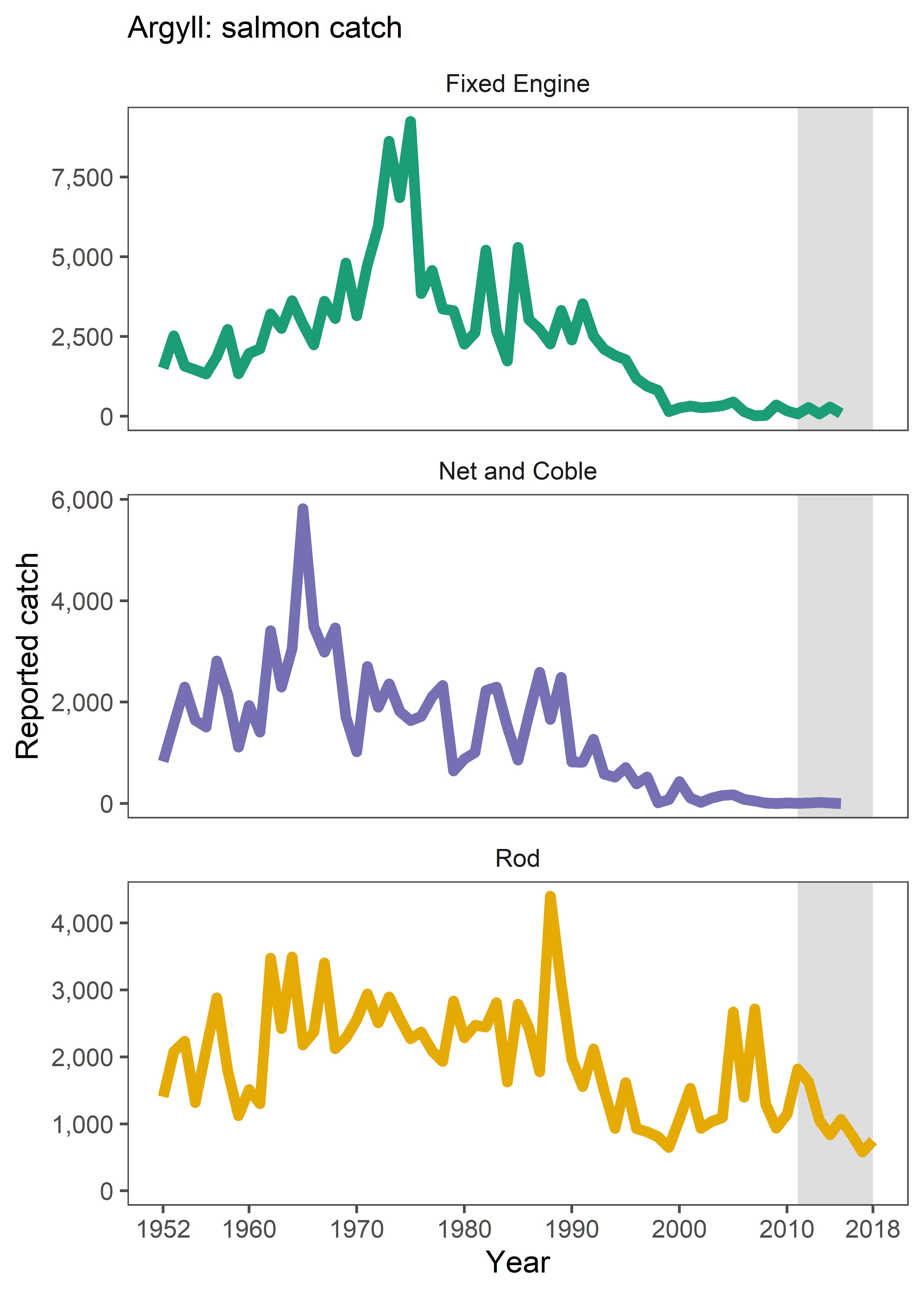
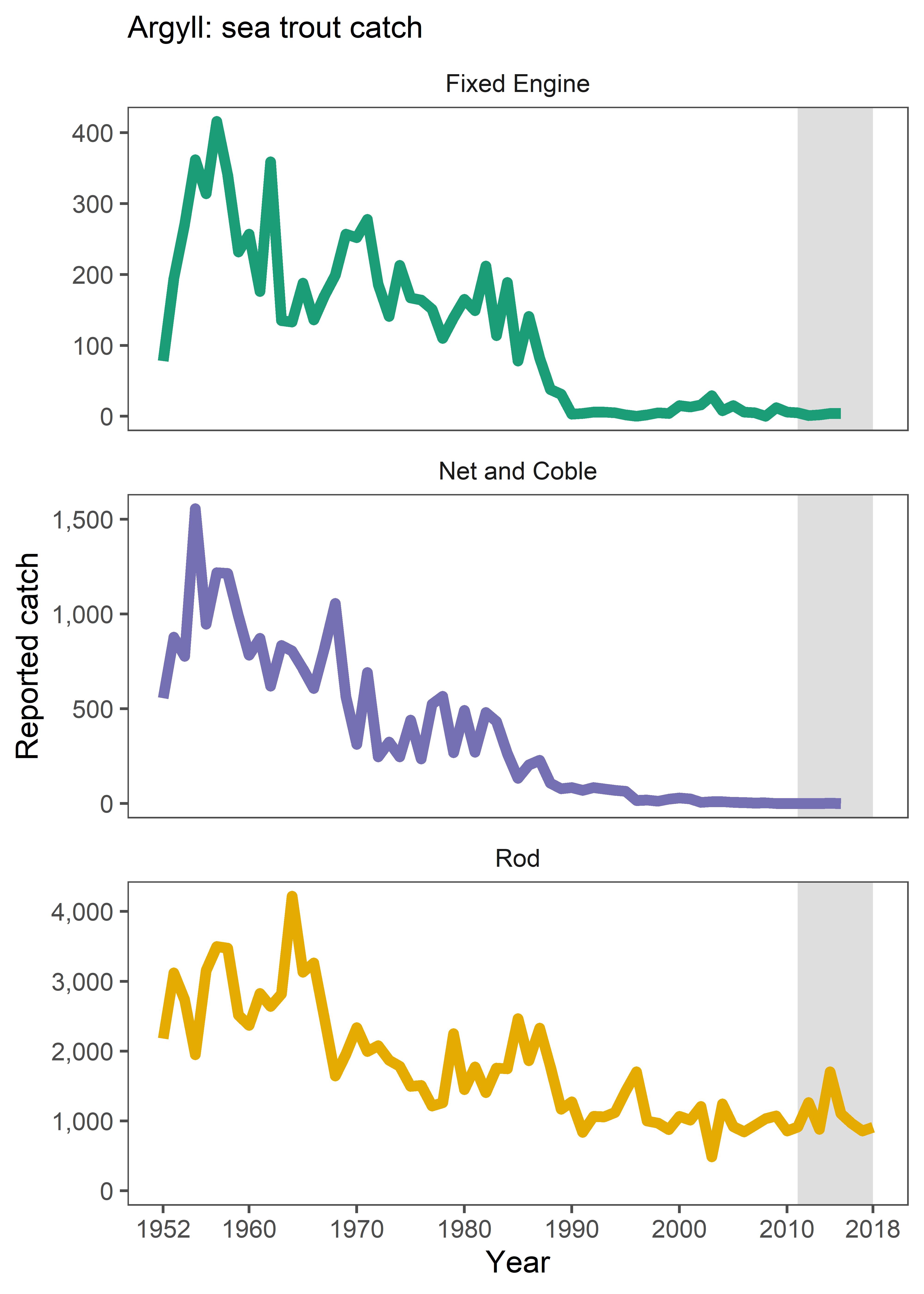
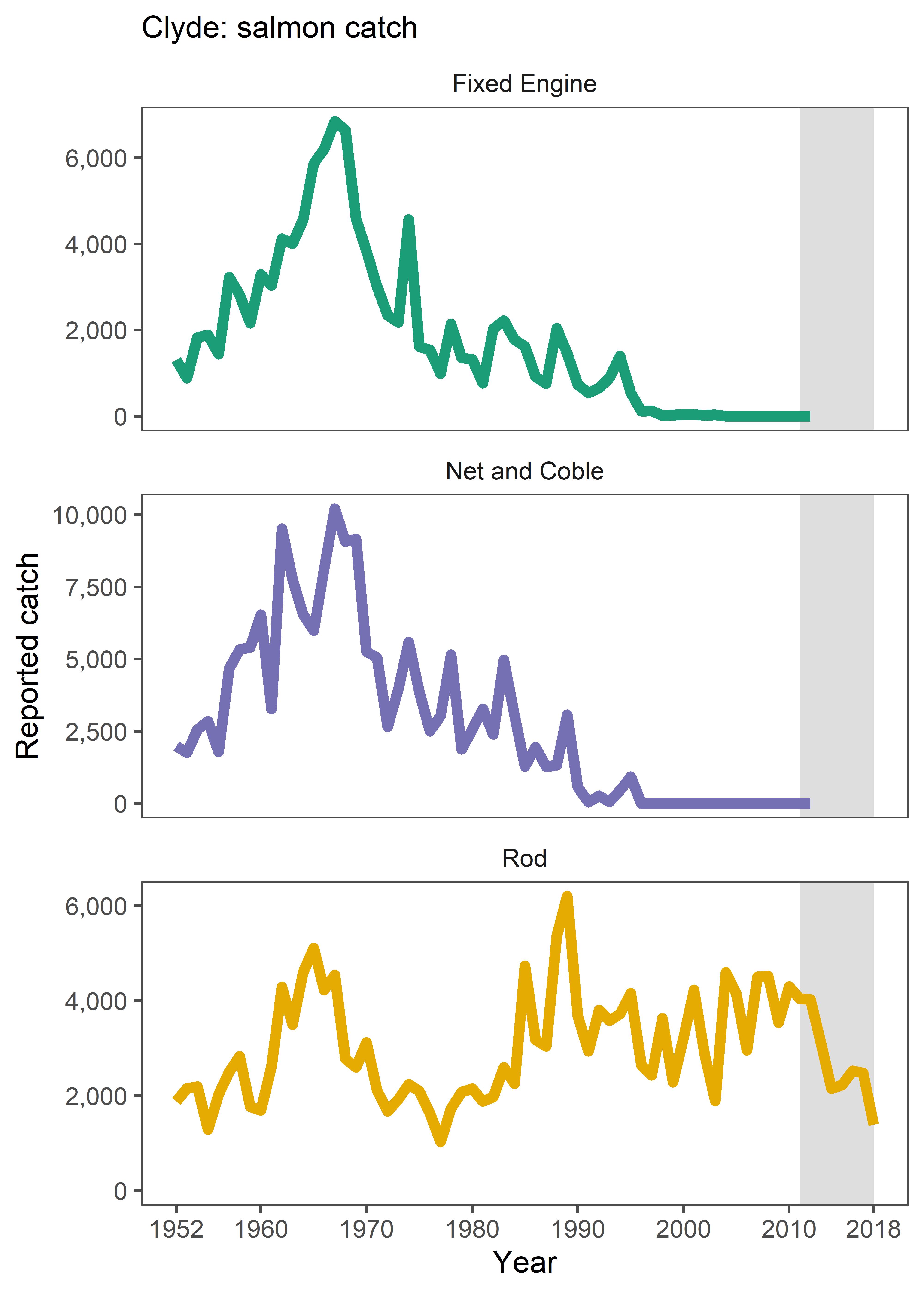
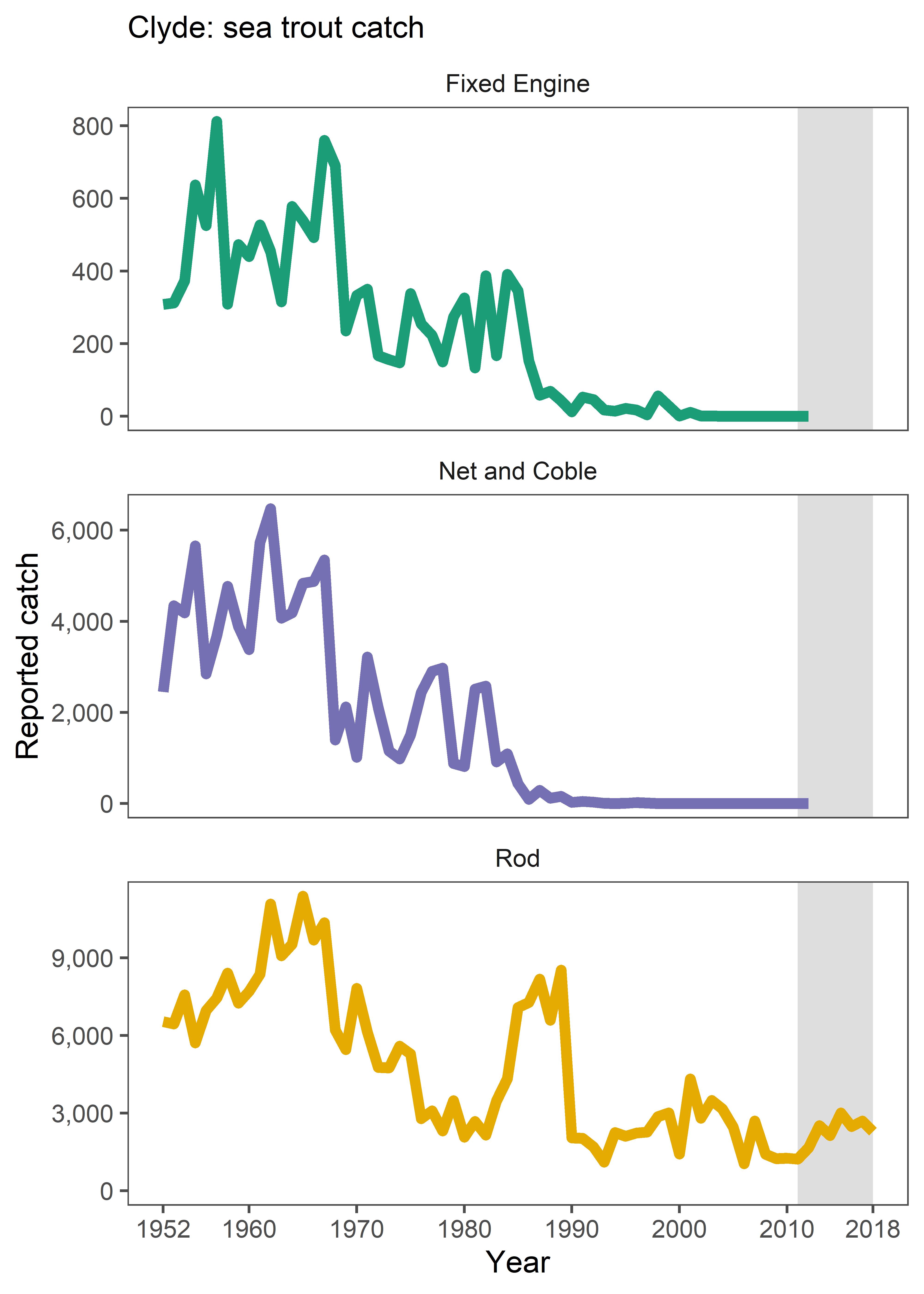
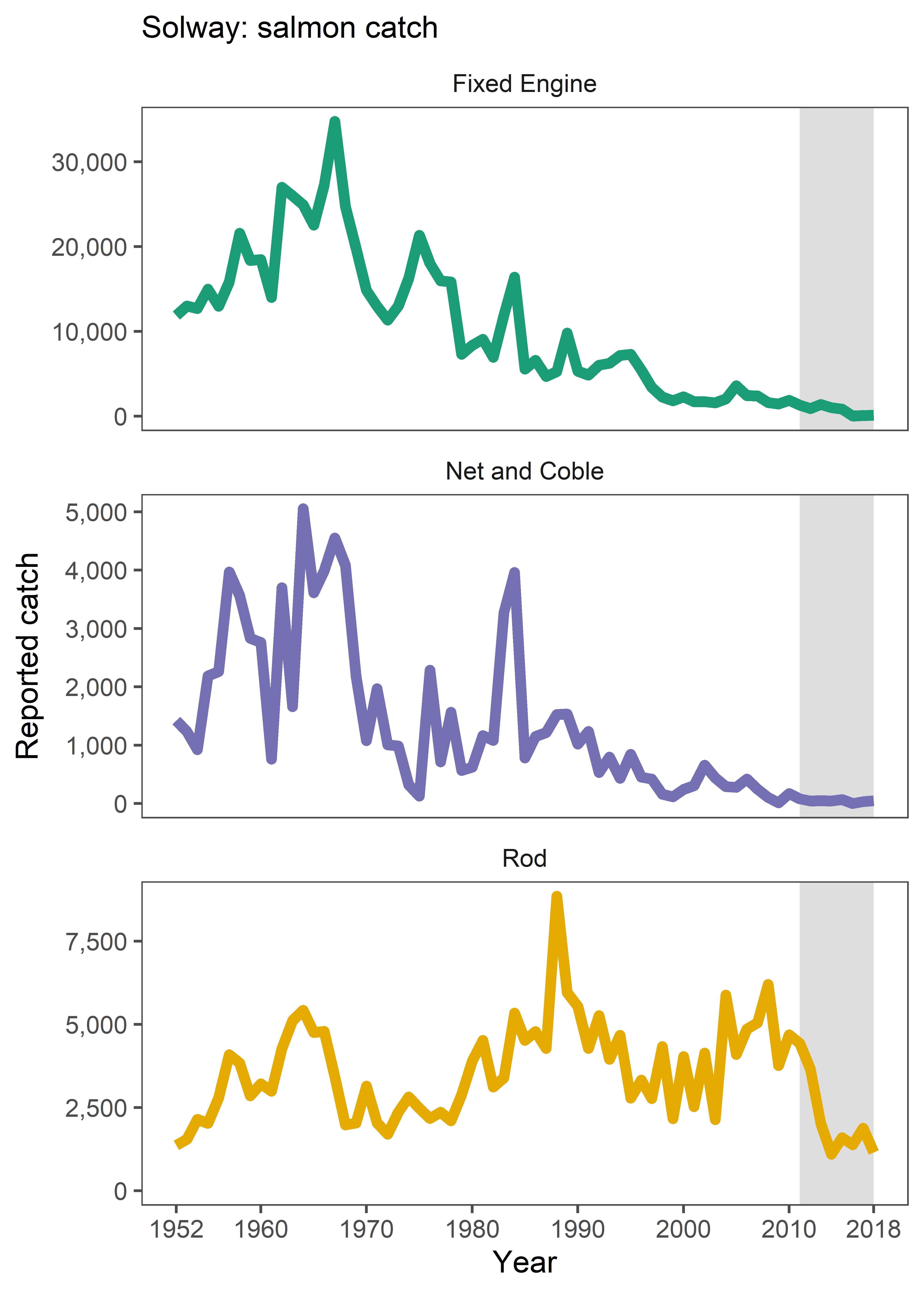
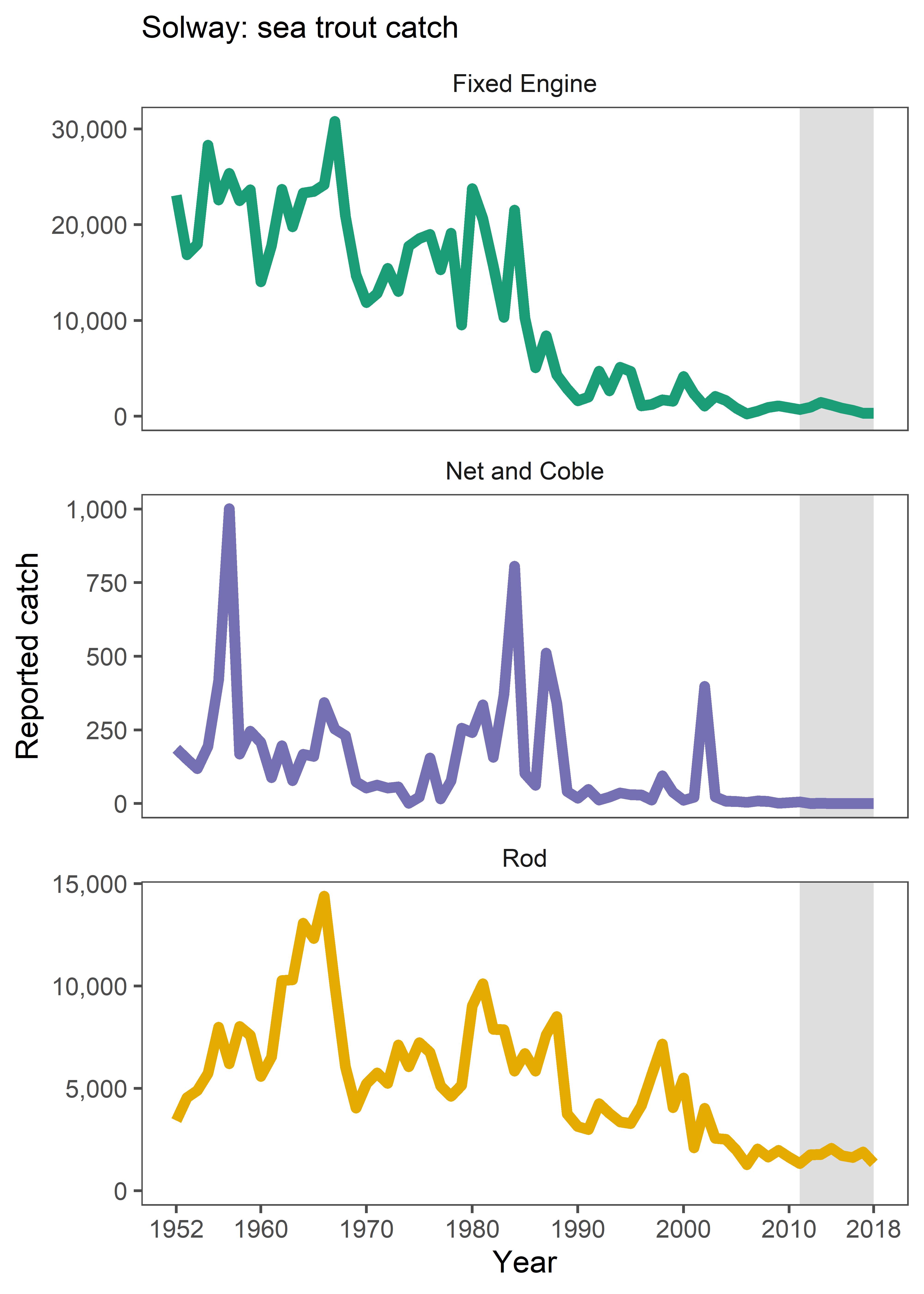
Source: Marine Scotland. Salmon and Sea Trout fishery statistics: 2018 Season - reported catch and effort by method. DOI: 10.4789/12206-1.
The catch data are based on survey results which do not have complete coverage (approximately 93% of catch forms are returned). Efforts have been made to increase the return rates, although the already high return rate supports the robustness of the observed trends.
All catches (rod, nets and fixed engine) can be ascribed to a catch location and so to an SMR. This, of course, does not reflect the stock for that SMR because individual salmon, and to a lesser extent sea trout, will pass through a number of regions during their migrations in the sea.
In addition to the annual salmon and sea trout fishery statistics the Scottish Marine and Recreation Tourism Survey (SMRTS) (Scottish Government, 2016) report gathered spatial data from over 2,500 respondents and improved awareness of what takes place where. SMARTS included sections on sea angling from a boat and from the shore which covers species in addition to salmon and sea trout and for which official catch statistics are not collected. Figure t shows the percentage of sea angling from the shore in each SMR, compared with the percentage of all recreation and tourist activities in the SMR. Solway, Clyde and Forth and Tay SMRs all account for over 20% each of sea angling from the shore. Around 20% of sea angling from a boat happens in each of Solway, Clyde and Argyll, with West Highland and Forth and Tay accounting for over 10% each. Figure u shows the percentage of sea angling from a private or chartered boat by SMR on the same basis.
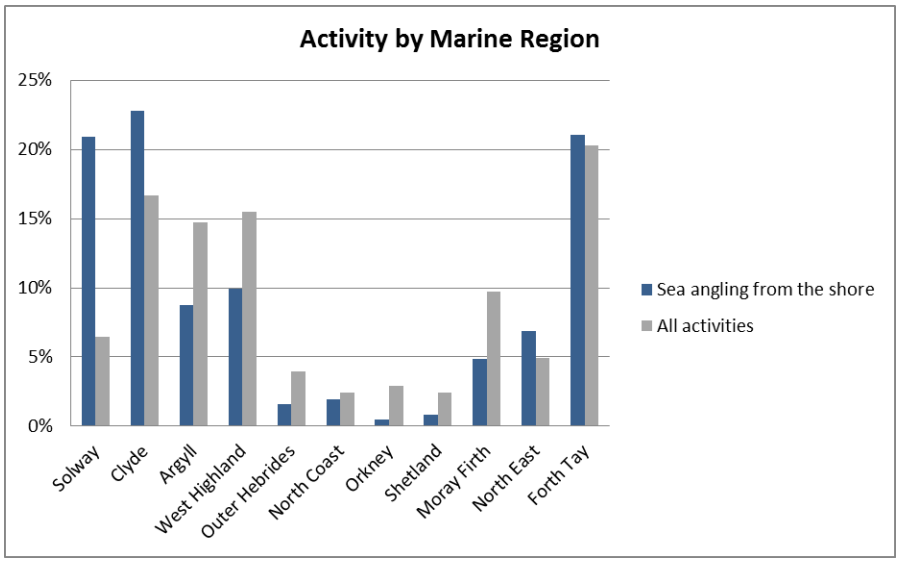
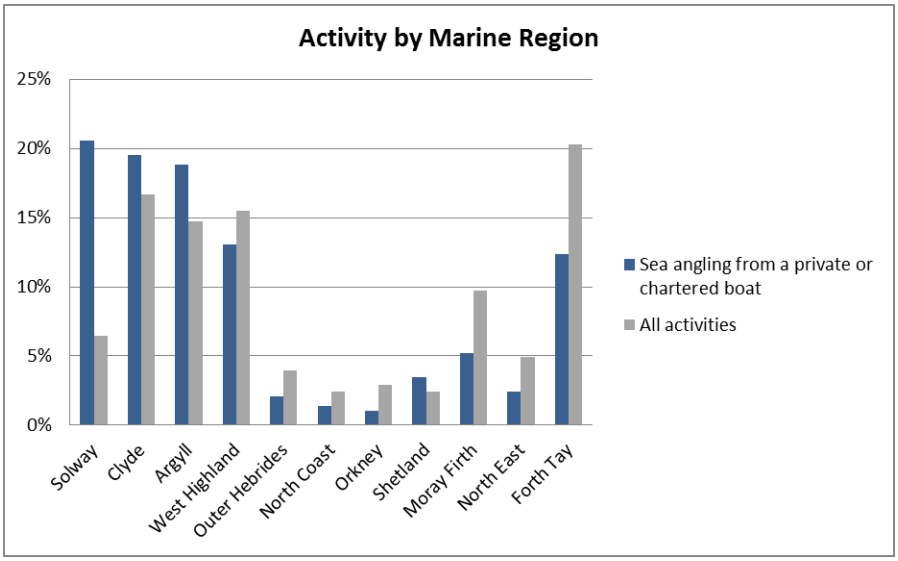
Figure u: Distribution of sea angling from a private or chartered boat by SMR – percentage compared to all leisure activities. Source: Scottish Marine Recreation and Tourism Survey 2015. (Scottish Government, 2016).
Figure v shows the SMRTS survey results for density of sea angling from the shore blended with results for sea angling from a private or chartered boat. Whereas the map is helpful to identify some busy areas, the study acknowledges that ‘survey design and method for data collection means the survey results are not representative of all marine recreation and tourism activities in Scotland, particularly in more remote areas, and information on activities with fewer participants is not to be taken as an indication that no activity takes place’.
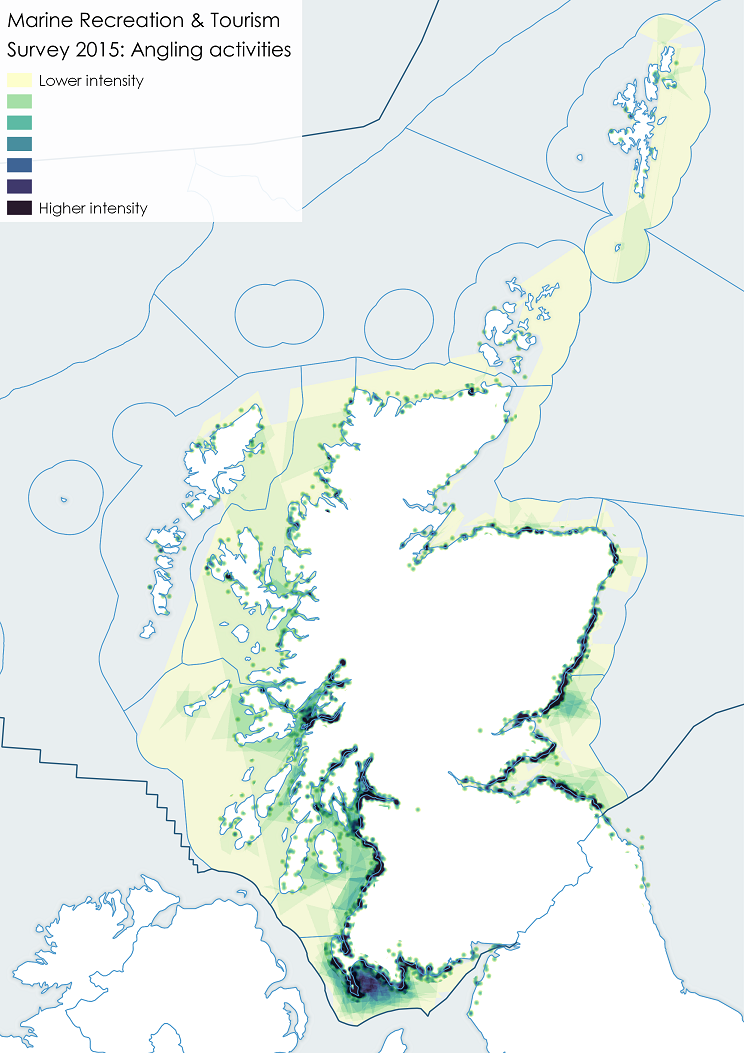
Based on two blended MS Maps NMPI layers (i) Sea angling from shore; and (ii) Sea angling from a private or chartered boat.
Contribution to the economy
There is no information on the economic contribution of salmon an sea trout fishing. Figures for Gross Value Added (GVA) and numbers employed cannot be obtained from the Scottish Annual Business Survey (SABS). It is also not possible to estimate their economic contribution from other sources, like The Scottish Marine Recreation & Tourism Survey 2015 (Scottish Government, 2016), as while the value of sea angling trips is estimated, the number of trips isn’t.
Employment tends to be seasonal, particularly in the net fisheries. The numbers fluctuate, with July being the month with the most employment in the net fisheries.
While the contribution to the economy from salmon and sea trout fishing is not collected in the SABS, salmon and sea trout fishing statistics are reported by catch method. Table 1 shows the weight of catch in 2018 and the change between 2014 and 2018 by catch method. The catches shown in Table 1 include all fish species reported in the statistics (wild salmon, wild grilse, sea trout, finnock, farmed salmon, farmed grilse).
Fixed engine catches have reduced to zero in all areas except Solway where the 2018 catch from the haaf net fishery was 905 kg.
Net and coble catches were reported in the Forth and Tay, North East and Solway SMRs. Only in the North East did the catches increase from 2014 to 2018, although from 2019 onwards the net and coble fishery on the North Esk (the main contributor to the North East SMRs catches) will no longer be operated.
|
Method
|
|
Change 2014 to 2018
|
||
|
SMR
|
Catch weight (kg) 2018
|
kg
|
%
|
Trend
|
|
Fixed engine
|
905
|
-42,613
|
-98%
|
↓
|
|
Argyll
|
0
|
-816
|
-100%
|
↓
|
|
Clyde
|
0
|
0
|
|
↔
|
|
Forth and Tay
|
0
|
-18,044
|
-100%
|
↓
|
|
Moray Firth
|
0
|
-6,089
|
-100%
|
↓
|
|
North Coast
|
0
|
-12,265
|
-100%
|
↓
|
|
North East
|
0
|
-1,572
|
-100%
|
↓
|
|
Outer Hebrides
|
0
|
0
|
|
↔
|
|
Solway
|
905
|
-3,797
|
-81%
|
↓
|
|
West Highlands
|
0
|
-30
|
-100%
|
↓
|
|
Net and Coble
|
13,436
|
-9,646
|
-42%
|
↓
|
|
Argyll
|
0
|
-32
|
-100%
|
↓
|
|
Clyde
|
0
|
0
|
|
↔
|
|
Forth and Tay
|
2,531
|
-10,396
|
-80%
|
↓
|
|
Moray Firth
|
0
|
-86
|
-100%
|
↓
|
|
North Coast
|
0
|
0
|
|
↔
|
|
North East
|
10,765
|
917
|
9%
|
↑
|
|
Outer Hebrides
|
0
|
-32
|
-100%
|
↓
|
|
Solway
|
140
|
-15
|
-10%
|
↓
|
|
West Highlands
|
0
|
-2
|
-100%
|
↓
|
|
Rod and Line
|
146,681
|
-49,796
|
-25%
|
↓
|
|
Argyll
|
3,387
|
-792
|
-19%
|
↓
|
|
Clyde
|
6,807
|
-2,224
|
-25%
|
↓
|
|
Forth and Tay
|
46,642
|
-21,724
|
-32%
|
↓
|
|
Moray Firth
|
47,482
|
-5,832
|
-11%
|
↓
|
|
North Coast
|
8,944
|
-4,456
|
-33%
|
↓
|
|
North East
|
20,212
|
-8,217
|
-29%
|
↓
|
|
Outer Hebrides
|
3,591
|
-3,895
|
-52%
|
↓
|
|
Solway
|
5,143
|
-547
|
-10%
|
↓
|
|
West Highlands
|
4,473
|
-2,111
|
-32%
|
↓
|
The Scottish Marine Recreation & Tourism Survey 2015 (Scottish Government, 2016) gathered information on sea angling from the shore and sea angling from a private or chartered boat. The analysis suggests a median spend of around £60 per day during trips to the coast involving angling from the shore and a median spend of around £100 per day during trips to the coast involving angling from a boat.
Looking at annual spend, again the range of spending was high and so the median spend figure was taken to provide an overall value. For trips to the coast involving angling from the shore the median annual figure for spending was around £300 and for trips to the coast involving angling from a boat was around £660.
Examples of socio-economic effects
- Tourism (for rod fisheries).
- Local employment.
- Iconic food product of Scotland (net fisheries only, rods not permitted to sell fish).
- Possible competition with other amenity users.
Pressures on the environment
An OSPAR agreed list of marine pressures is used to help assessments of human activities in the marine environment. The marine pressure list has been adapted for use in Scotland via work on the Feature Activity Sensitivity Tool (FeAST). Salmon and sea trout fishing activities can be associated with 12 marine pressures – please read the pressure descriptions and benchmarks for further detail.
The list of marine pressures is used to help standardise assessments of activities on the marine environment, and is adapted from an agreed list prepared by OSPAR Intercessional Correspondence Group on Cumulative Effects (ICG-C) (see OSPAR 2014-02 ‘OSPAR Joint Assessment and Monitoring Programme (JAMP) 2014-2021’ Update 2018’ (Table II).
The Feature Activity Sensitivity Tool (FeAST) uses the marine pressure list to allow users to investigate the sensitivity of Scottish marine features. It also associates all pressures that might be exerted by a defined list of activities at a particular benchmark. The extent and impact of each pressure from a given activity will vary according to its intensity or frequency. The extent and impact of the pressure will also vary depending on the sensitivity of the habitat or species on which it is acting. The existence of multiple activities, and potentially multiple pressures, at specific locations will result in a cumulative impact on the environment.
FeAST is a developing tool. A snap shot from 2019 was used for the development of SMA2020. Please consult the FeAST webpage for further information and up to date information.
The list of pressures below associated with this activity is given in alphabetical order. Clicking the pressure will give you more information on the pressure and examples of how it may be associated with the activity.
| FeAST Activity | FeAST pressures |
|---|---|
| Fishing – any gear | |
| Fishing - Recreational Fishing | |
| Fishing - Set (fixed) net fishing (GEN, GN, GNF, GNS, GTN, GTR) |
Forward look
The sector's future very much depends on the status of stocks together with the general economic situation. With a range-wide decline in salmon numbers and concerns over the conservation status of stocks throughout Scotland it is unlikely that the prohibition on coastal netting will be lifted in the near future. The decline in the estuarine nets also looks set to continue with the largest active station being bought out by wild fisheries interests in 2019. The future for rod fisheries will also be dependent on salmon and trout numbers coming back to rivers. Marine Scotland will continue to monitor the status of both stocks and fisheries.
Economic trend assessment
The trend is based on the change in the combined catch weight, in kg, of salmon and sea trout by SMR and for Scotland as a whole. A change of less than 5% is shown as stable (↔). The rod and line catch weight for Shetland SMR has been excluded from this analysis due to data quality concerns, this does not affect the overall trend.
Lowest available geography is salmon fishery districts which have been aggregated into Scottish Marine Regions.
Confidence is **. Based on published statistics but there are concerns about data quality in Shetland SMR which has been excluded from trends.
|
Method Region |
Trend |
|
Total catch weight of salmon and sea trout |
|
|
Argyll |
|
|
Clyde |
|
|
Forth and Tay |
|
|
Moray Firth |
|
|
North Coast |
|
|
North East |
|
|
Outer Hebrides |
|
|
Solway |
|
|
West Highlands |
|
|
Scotland |
|
This Legend block contains the key for the status and trend assessment, the confidence assessment and the assessment regions (SMRs and OMRs or other regions used). More information on the various regions used in SMA2020 is available on the Assessment processes and methods page.
Status and trend assessment
|
Status assessment
(for Clean and safe, Healthy and biologically diverse assessments)
|
Trend assessment
(for Clean and safe, Healthy and biologically diverse and Productive assessments)
|
||
|---|---|---|---|
 |
Many concerns |
No / little change |
|
 |
Some concerns |
Increasing |
|
 |
Few or no concerns |
Decreasing |
|
 |
Few or no concerns, but some local concerns |
No trend discernible |
|
 |
Few or no concerns, but many local concerns |
All trends | |
 |
Some concerns, but many local concerns |
||
 |
Lack of evidence / robust assessment criteria |
||
| Lack of regional evidence / robust assessment criteria, but no or few concerns for some local areas | |||
 |
Lack of regional evidence / robust assessment criteria, but some concerns for some local areas | ||
| Lack of regional evidence / robust assessment criteria, but many concerns for some local areas | |||
Confidence assessment
|
Symbol |
Confidence rating |
|---|---|
|
Low |
|
|
Medium |
|
|
High |

Assessment regions

Key: S1, Forth and Tay; S2, North East; S3, Moray Firth; S4 Orkney Islands, S5, Shetland Isles; S6, North Coast; S7, West Highlands; S8, Outer Hebrides; S9, Argyll; S10, Clyde; S11, Solway; O1, Long Forties, O2, Fladen and Moray Firth Offshore; O3, East Shetland Shelf; O4, North and West Shetland Shelf; O5, Faroe-Shetland Channel; O6, North Scotland Shelf; O7, Hebrides Shelf; O8, Bailey; O9, Rockall; O10, Hatton.



